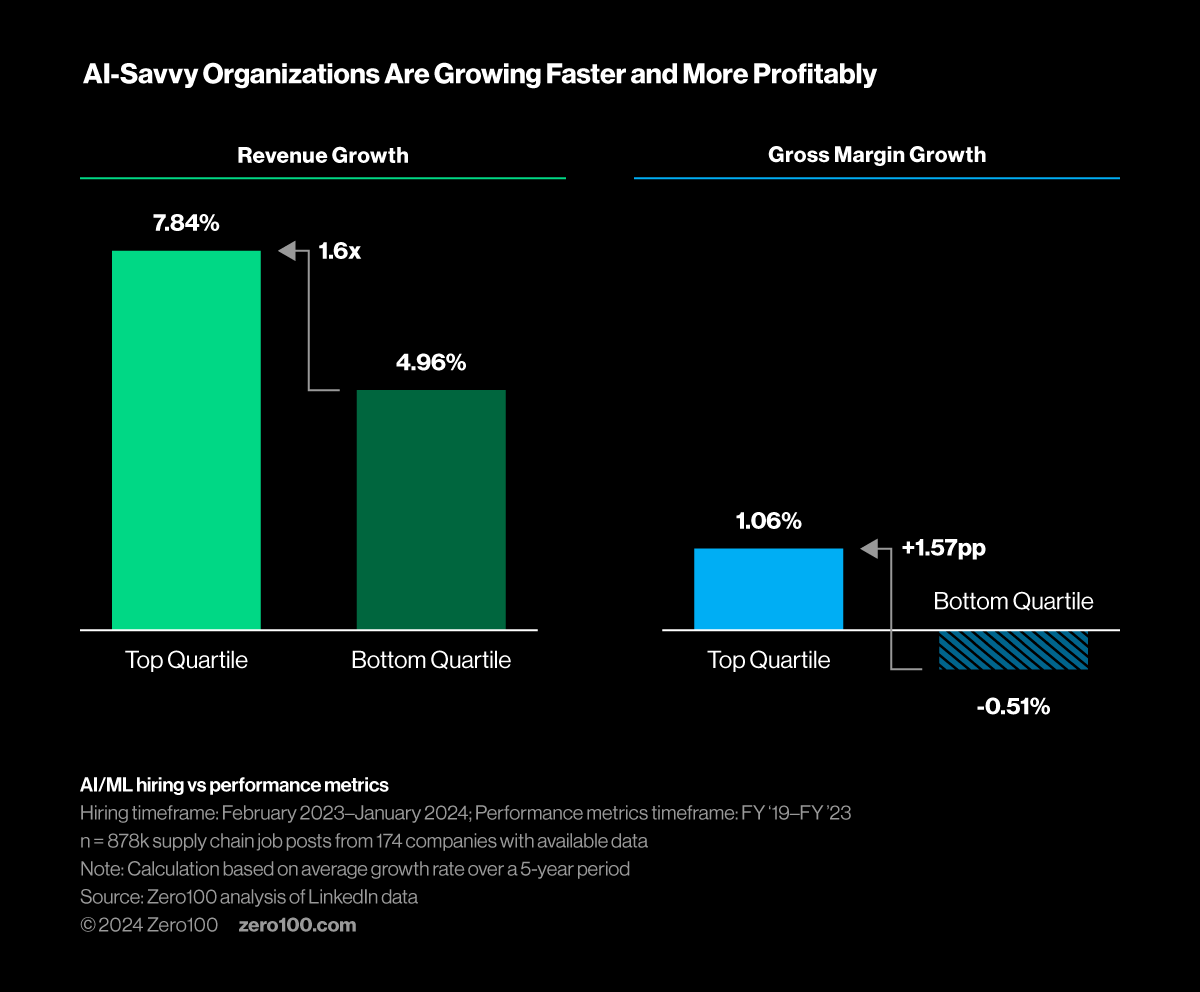

4M+ Jobs Show a Digital Strategy for Supply Chain
Digital success leads to financial reward. But that success relies on hiring the right talent. Are you looking in the best way possible? Hiring who you really need? Upskilling internally? Here's the data, details, and our recommendations.
Key Takeaways
-
1
Job postings are a good proxy for digital skills investments: companies demonstrate digital maturity or reveal the skills they need for upcoming digital initiatives. When correlated with performance results, AI/ML hiring leaders have 1.6x the revenue growth of laggards.
-
2
Technical skills (AI, analytics, software engineering, etc) fused with continuous improvement, creativity, and problem solving are the supply chain skills of the future – showing significant growth over the past few years.
I recently sat down with Kevin O’Marah, Zero100 Co-Founder and Chief Research Officer, to reminisce about his early days as a supply chain analyst.
He needed data to explain the success of Apple’s supply chain but knew they were notoriously secret about their various initiatives and strategies. Kevin’s eureka moment came after looking through their job descriptions. He found his answers and delivered another successful presentation.
We have the same approach today at Zero100.
We analyzed over four million LinkedIn job posts from 250 B2B and B2C companies to search for answers to the question: who’s investing in digital in supply chain?
We isolated the job descriptions that feature digital skills like AI/ML, analytics, and robotics. We found there is plenty of room for progress as, on average, only a fifth of supply chain jobs “speak” digital.
Let’s not forget that the definition of digital has drastically changed. For a supply chain analyst role in 2010, “advanced excel” consisted of VLOOKUPs, and “advanced computer skills” required knowledge of MS Office… Now, for a similar role, Schneider Electric looks for candidates with SQL, Python, and Tableau skills; degrees in computer science; “business sense, intellectual curiosity, and [a] growth mindset.” We’re only interested in these latter, modern skills.
If you were wondering, yes, Schneider Electric is a digital leader. 65% of their supply chain jobs require digital skills – over three times the average. In particular, they are building out their software engineering capabilities (13% of jobs, double the B2B average) as they develop future digital supply chain analysts.
Digital initiatives run by great, technically literate people also correlate with superior financial performance. Those who lead on AI hiring in supply chain have 1.6x the rate of revenue growth and are putting billions of incremental margin dollars to the bottom line relative to those less aggressive on AI investment. And, since we’re looking at revenue growth from 2019 to 2023, this is really the rearview mirror, which has barely registered the recent explosion in genAI innovation. If anything, this business case is understated.

The foundations for digital success rely on hiring the right talent. And the companies that do this well are already reaping the financial rewards. It’s essential to work out which skills you need to drive your next initiatives and hire accordingly. But this shouldn’t be done in a vacuum. Everyone should have a baseline of digital skills, curiosity, and a willingness to learn and improve. As you think about external hiring, don’t neglect existing employees either. Resources for upskilling are abundant thanks to third-party training from the likes of Unilever/Coursera and Google. Or, to uncover skill and resource gaps, try Gloat’s Agile Workforce Operating system to further develop people and break down silos.
Successful digital initiatives require great people.
Go find them.
Methodology
Zero100’s proprietary data and analytics are a combined effort between our data scientists and research analysts. We provide data-first insights matched with our own research-backed points of view and bring this analysis to life via real-world case examples being led by supply chain practitioners today.